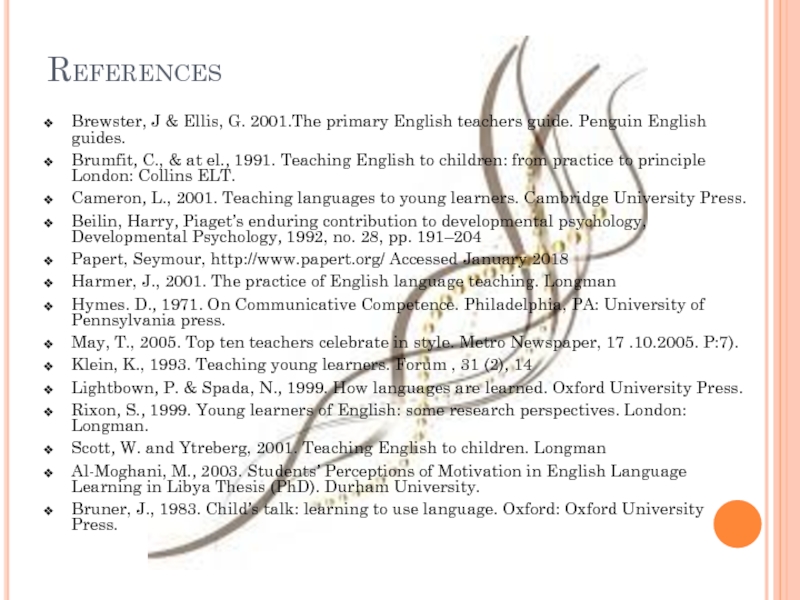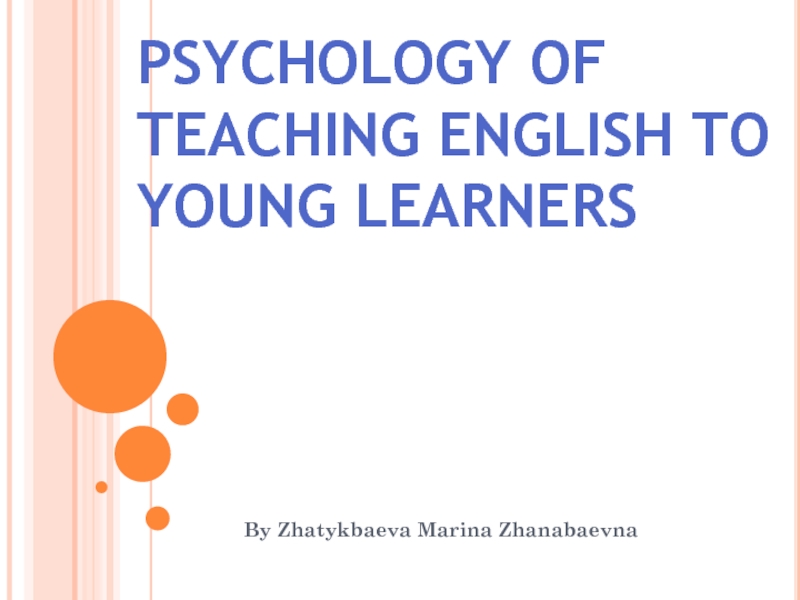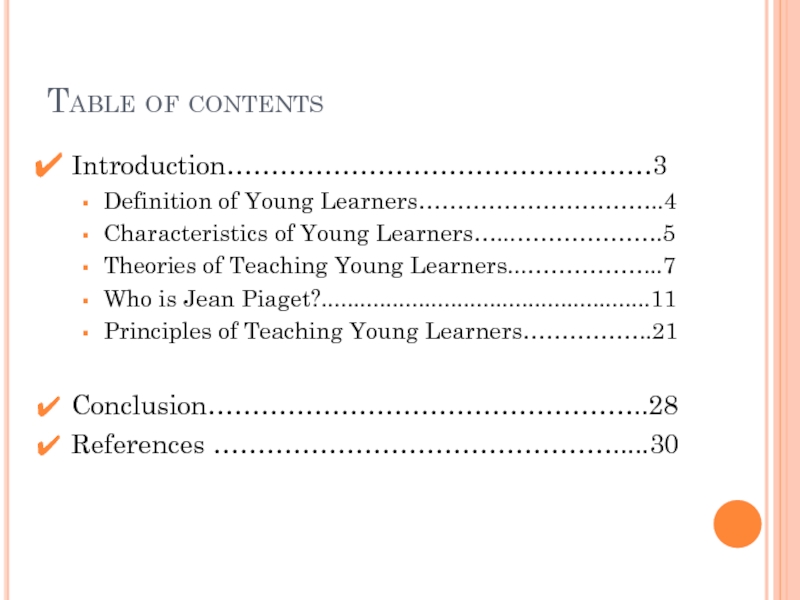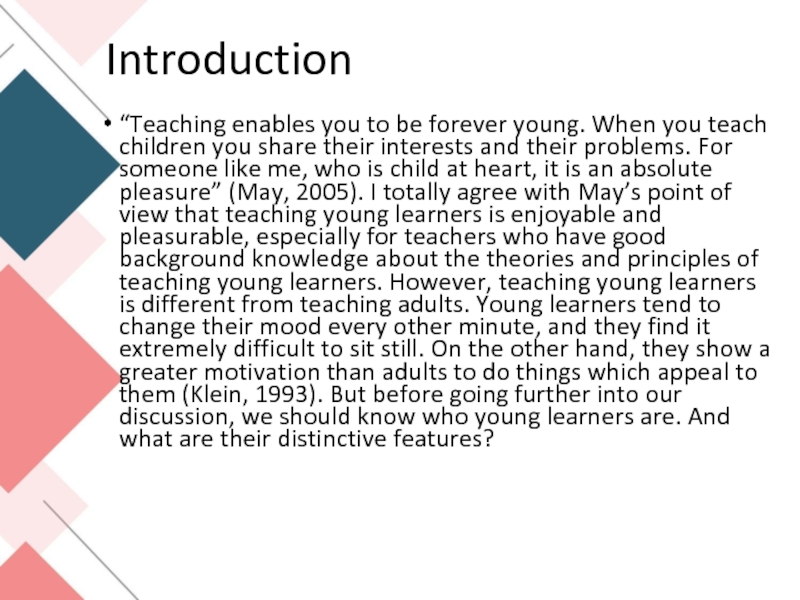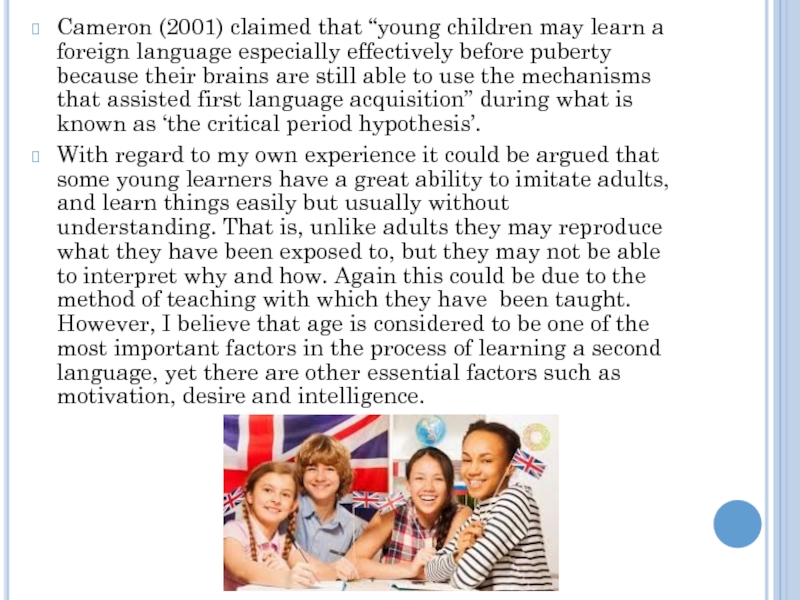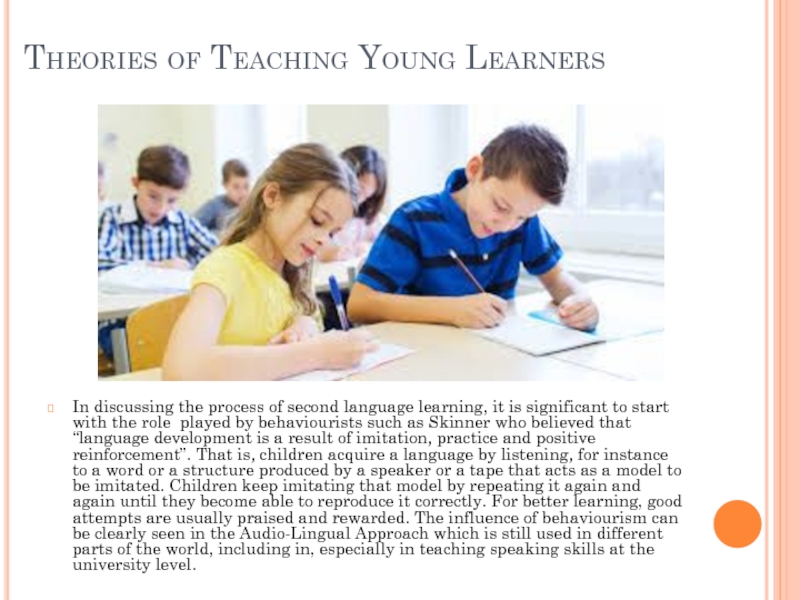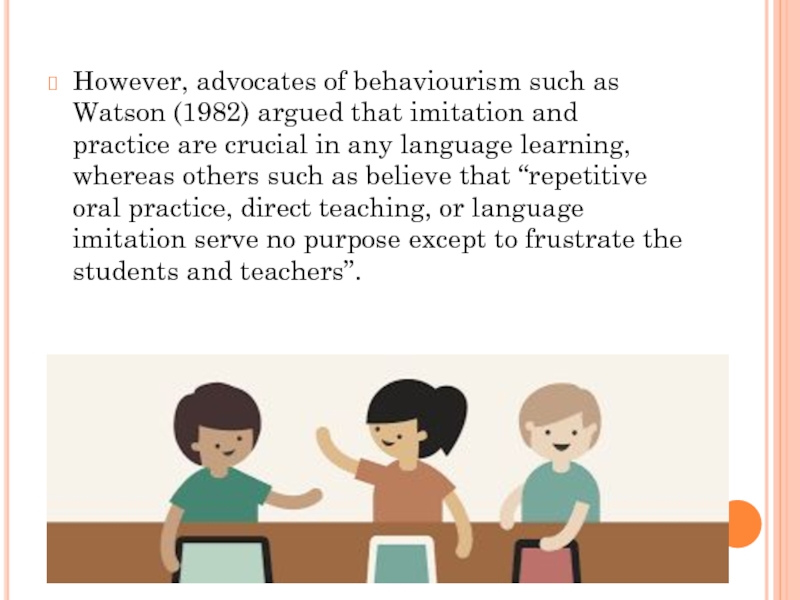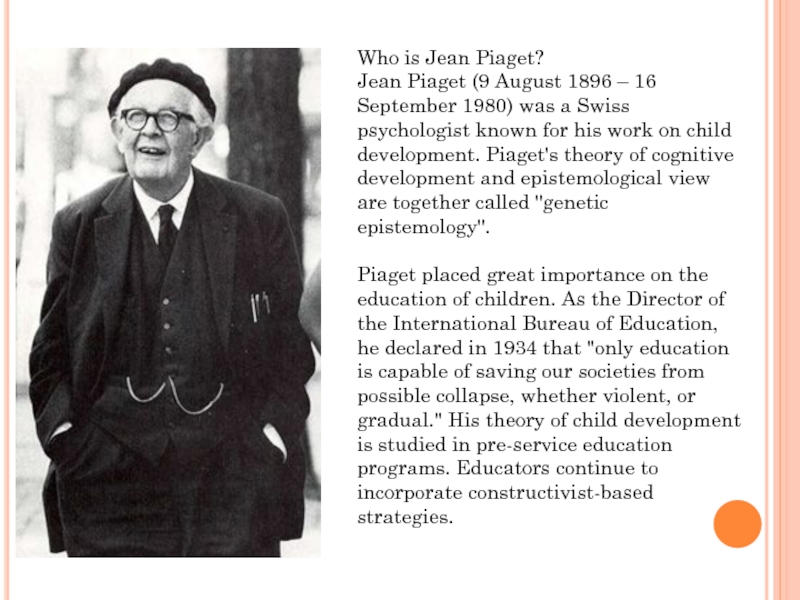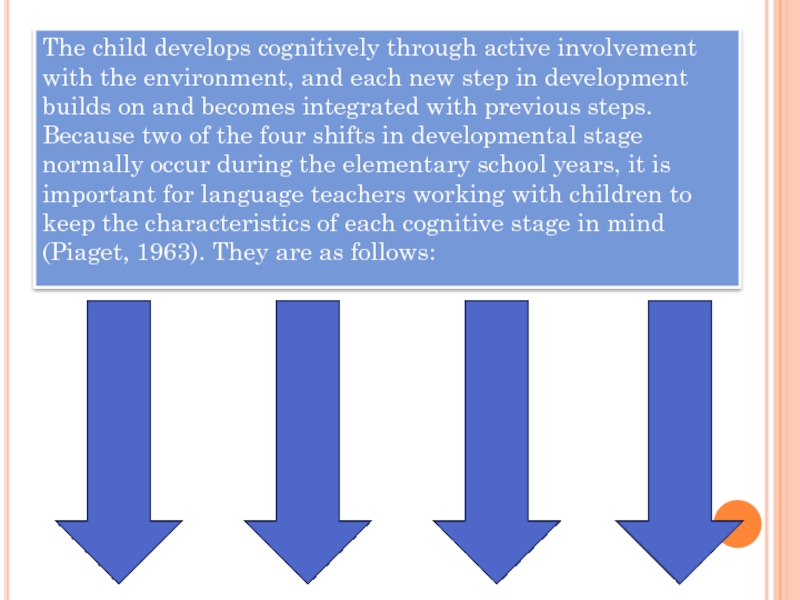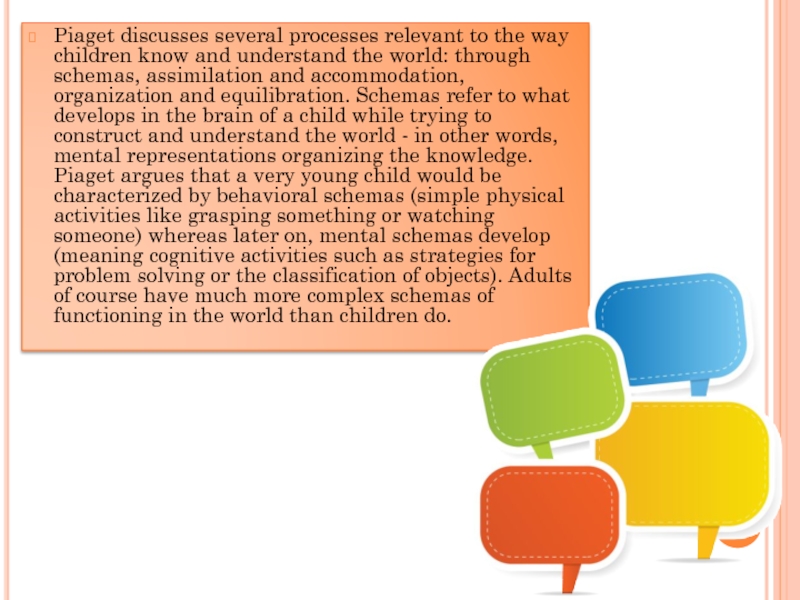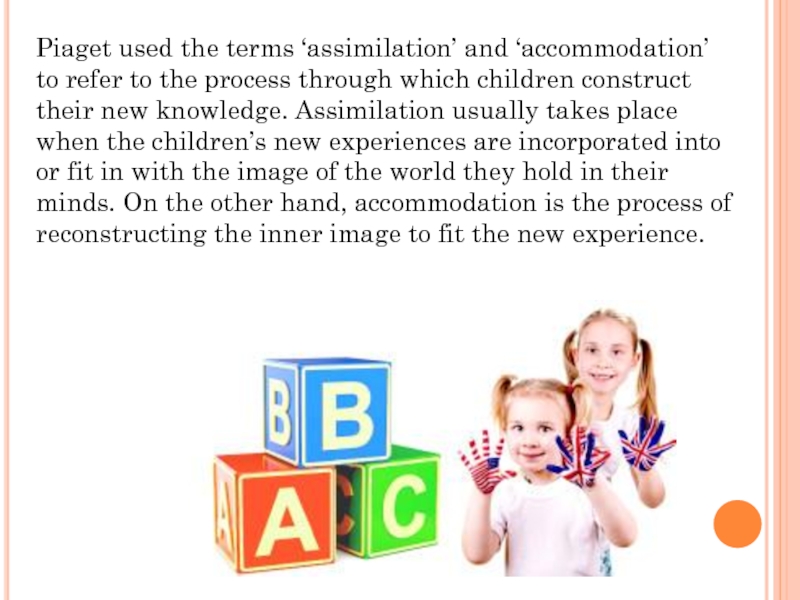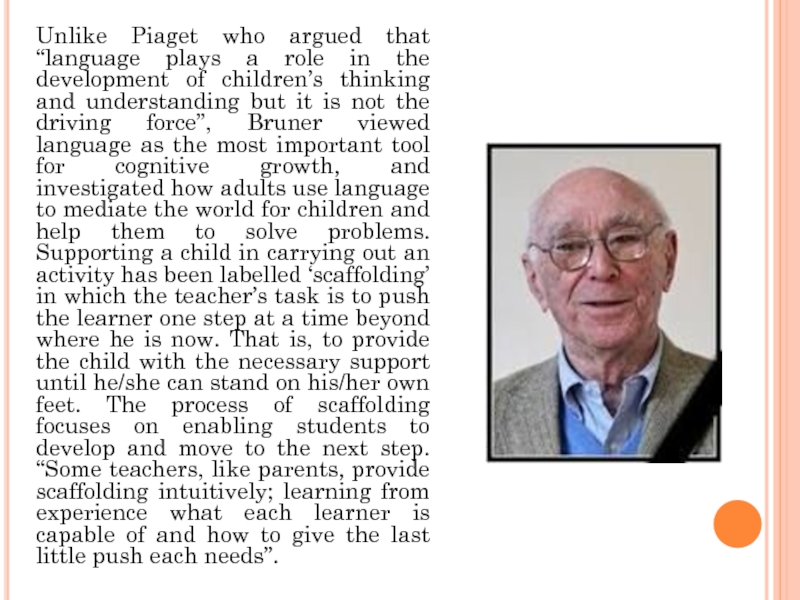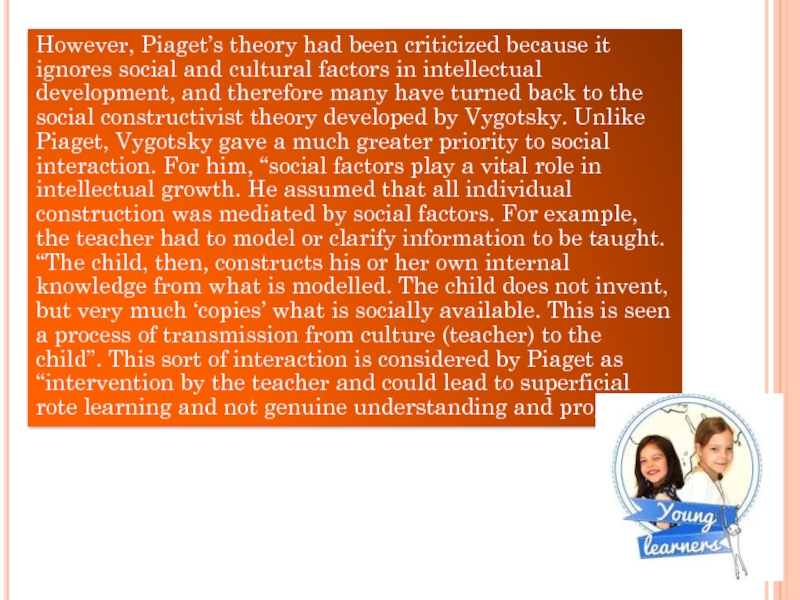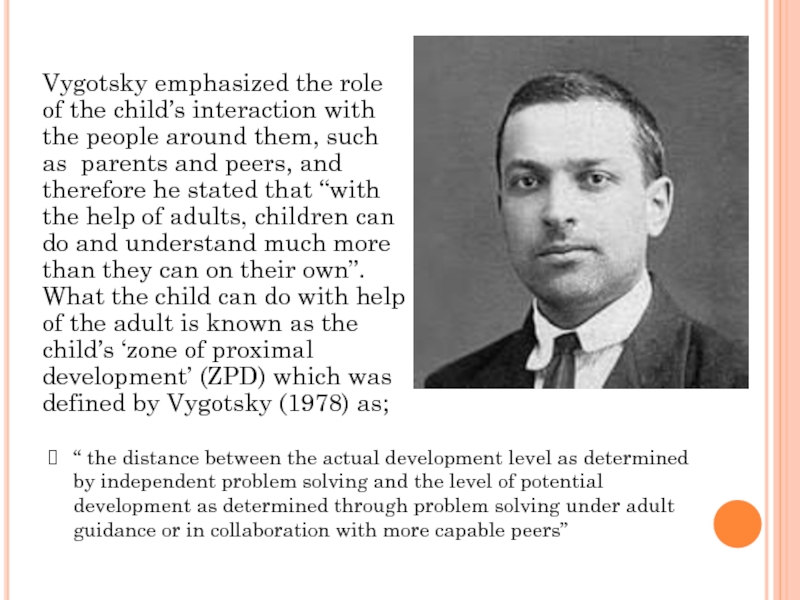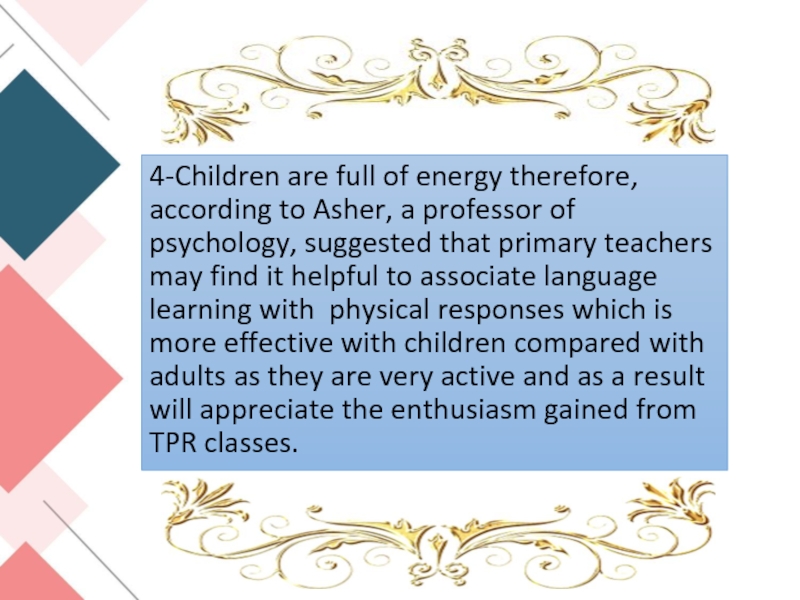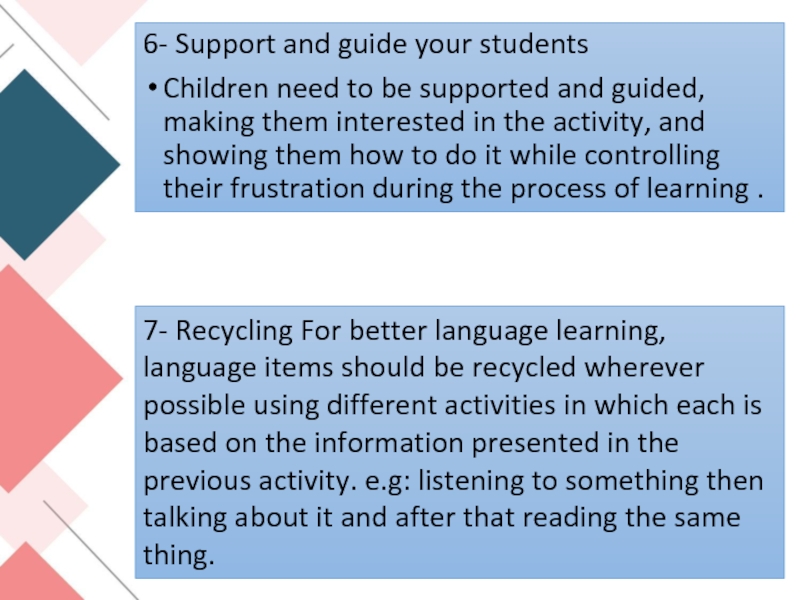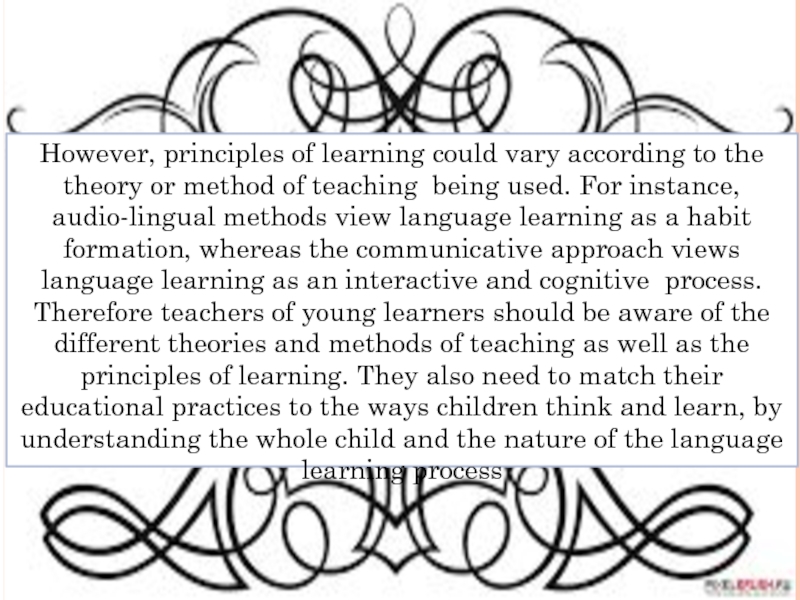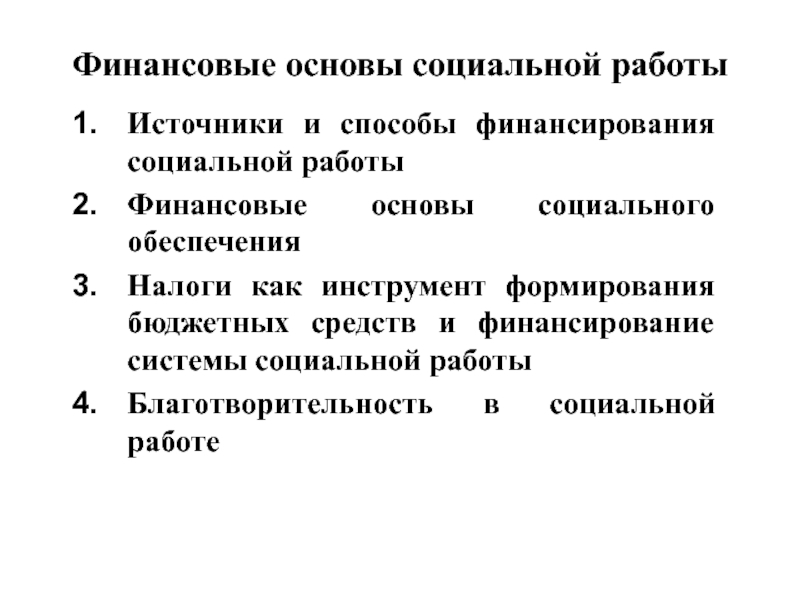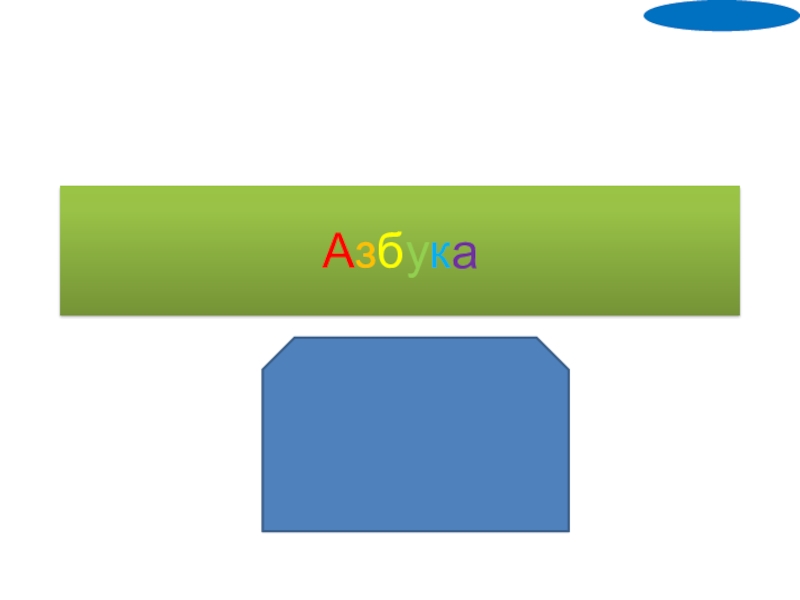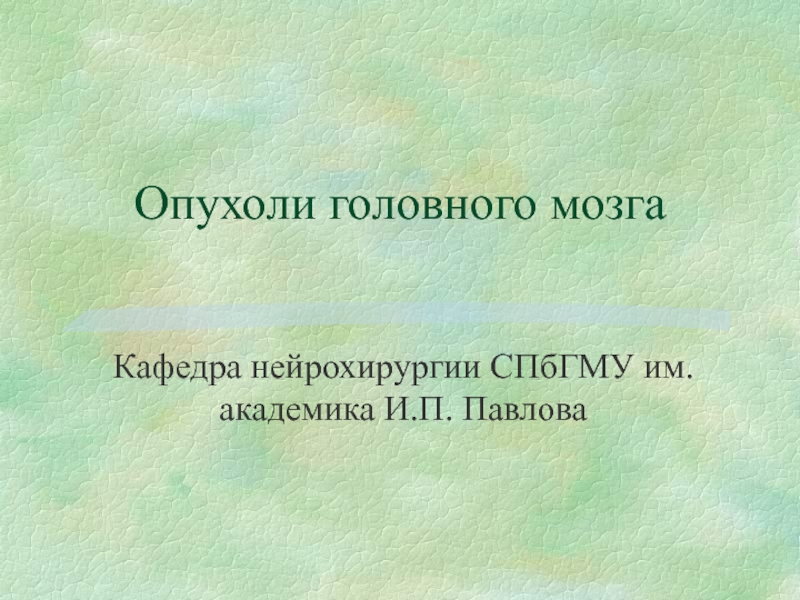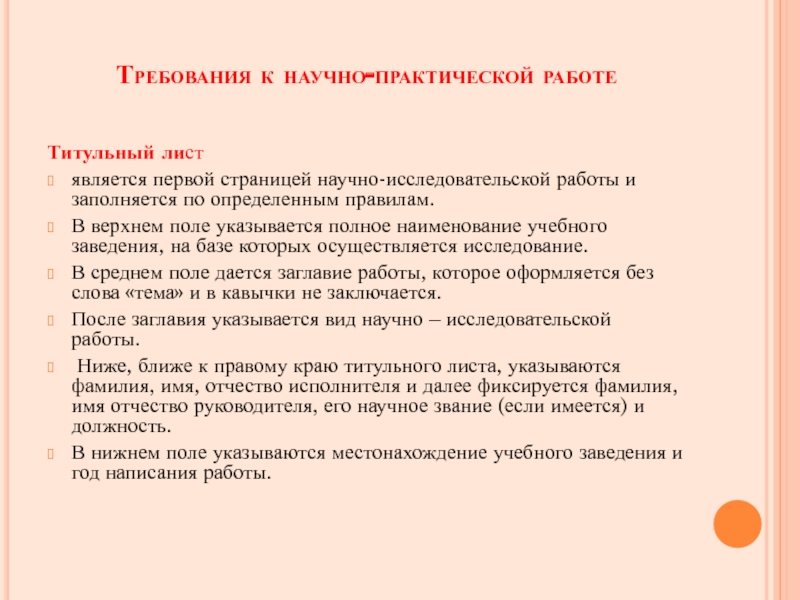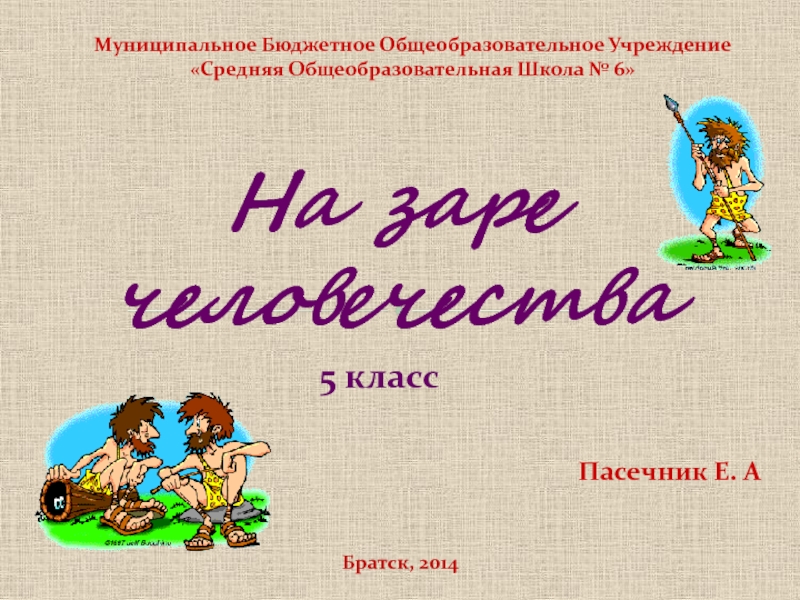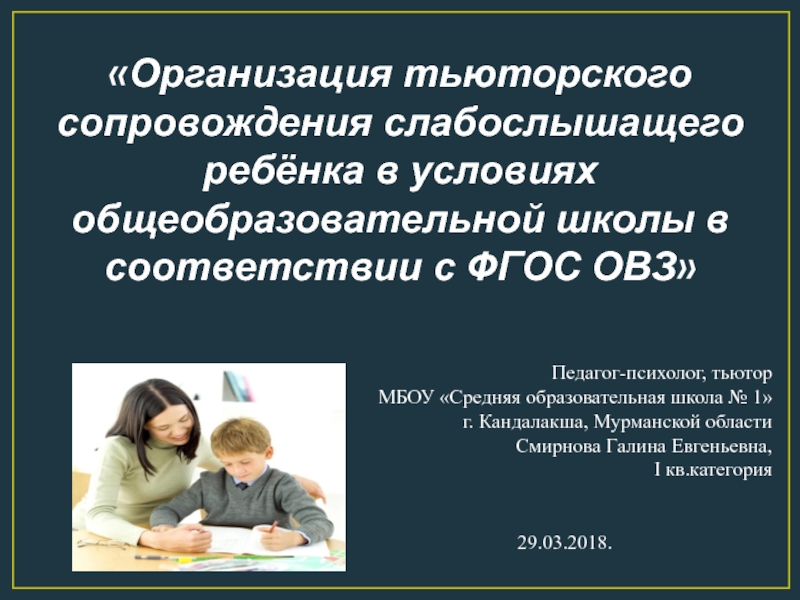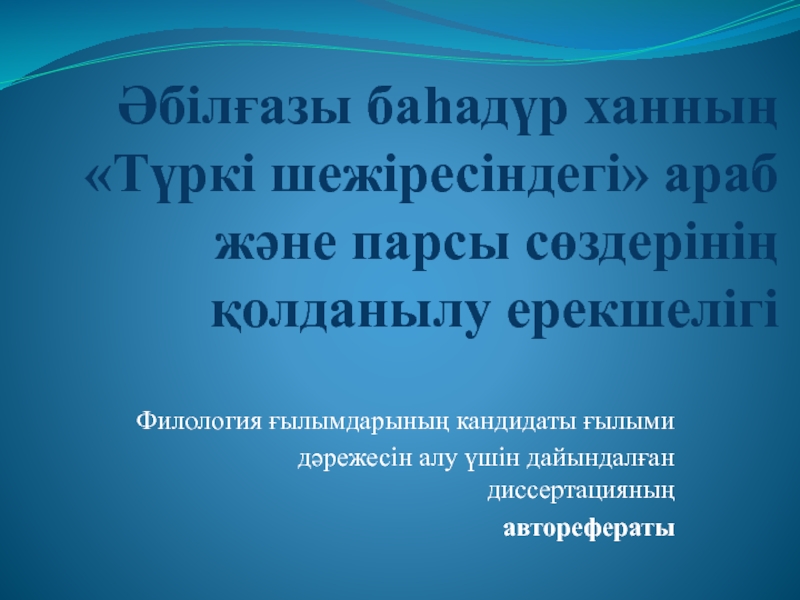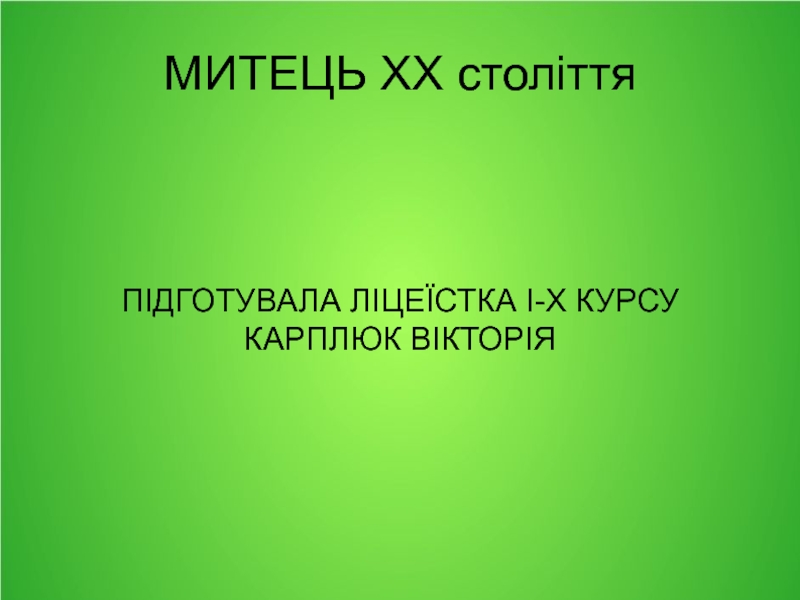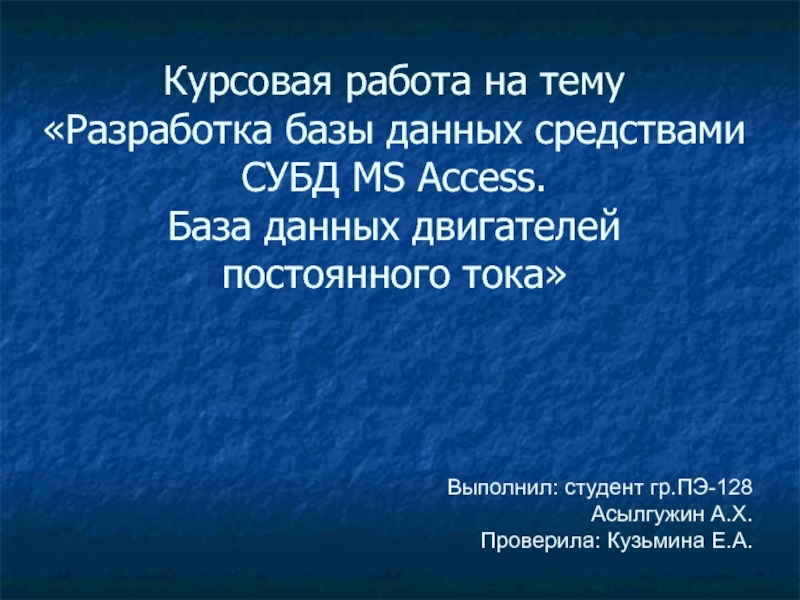Слайд 1By Zhatykbaeva Marina Zhanabaevna
Psychology of teaching English to young learners
Слайд 2Table of contents
Introduction…………………………………………3
Definition of Young Learners…………………………..4
Characteristics of Young Learners…...……………….5
Theories
of Teaching Young Learners...……………...7
Who is Jean Piaget?...................................................11
Principles of Teaching Young
Learners……………..21
Conclusion…………………………………………..28
References ……………………………………….....30
Слайд 3Introduction
“Teaching enables you to be forever young. When you teach
children you share their interests and their problems. For someone
like me, who is child at heart, it is an absolute pleasure” (May, 2005). I totally agree with May’s point of view that teaching young learners is enjoyable and pleasurable, especially for teachers who have good background knowledge about the theories and principles of teaching young learners. However, teaching young learners is different from teaching adults. Young learners tend to change their mood every other minute, and they find it extremely difficult to sit still. On the other hand, they show a greater motivation than adults to do things which appeal to them (Klein, 1993). But before going further into our discussion, we should know who young learners are. And what are their distinctive features?
Слайд 4Definition of Young Learners
According to the education system in Libya,
‘young learners’ are those who are studying in basic education
between six and fifteen, while some teachers think that young learners are only those aged twelve and below. From the literature review, there is some controversy on specifying the exact age of a ‘young learner’. For example, Rixon (1999) and Phillips (1993) defined young learners as those aged between five and twelve years old. Scott & Ytreberg (2001) have their own classification in which they divided young learners into two main groups, five to seven olds, and eight to ten year olds. They added that each group has its own abilities in doing things and recognizing the world around them.
Слайд 5Characteristics of Young Learners
Unlike adults, young learners have their own
features which need to be understood by those who wish
to be successful teachers of young learners. For instance, Brumfit (1991) described young learners as keen, enthusiastic and motivated learners, who can be easily stimulated. Another striking feature of young learners is that they have a greater facility than adult learners for understanding and imitating what they hear. Other characteristics listed by Scott & Ytreberg include that five to seven years olds understand situations more quickly than they understand the language used, have a very short attention and concentration span, and sometimes they have difficulties in knowing what is fact and what is fiction; whereas eight to ten years olds can tell the difference between fact and fiction, ask questions all the time, rely on the spoken word as well as the physical world to convey and understand meaning, and have the ability to work with and learn from others.
Слайд 6Cameron (2001) claimed that “young children may learn a foreign
language especially effectively before puberty because their brains are still
able to use the mechanisms that assisted first language acquisition” during what is known as ‘the critical period hypothesis’.
With regard to my own experience it could be argued that some young learners have a great ability to imitate adults, and learn things easily but usually without understanding. That is, unlike adults they may reproduce what they have been exposed to, but they may not be able to interpret why and how. Again this could be due to the method of teaching with which they have been taught. However, I believe that age is considered to be one of the most important factors in the process of learning a second language, yet there are other essential factors such as motivation, desire and intelligence.
Слайд 7Theories of Teaching Young Learners
In discussing the process of second
language learning, it is significant to start with the role
played by behaviourists such as Skinner who believed that “language development is a result of imitation, practice and positive reinforcement”. That is, children acquire a language by listening, for instance to a word or a structure produced by a speaker or a tape that acts as a model to be imitated. Children keep imitating that model by repeating it again and again until they become able to reproduce it correctly. For better learning, good attempts are usually praised and rewarded. The influence of behaviourism can be clearly seen in the Audio-Lingual Approach which is still used in different parts of the world, including in, especially in teaching speaking skills at the university level.
Слайд 8Nasef, 2004 investigated the difficulties encountered by some Libyan university
students in acquiring English speaking skills, and found that students
who were taught by the Audio Lingual Approach very often fail to use different patterns of dialogues they have already mastered in different situations.
Слайд 9However, advocates of behaviourism such as Watson (1982) argued that
imitation and practice are crucial in any language learning, whereas
others such as believe that “repetitive oral practice, direct teaching, or language imitation serve no purpose except to frustrate the students and teachers”.
Слайд 10However, behaviourism has been criticized by many researchers and theorists.
The most prominent of these was Chomsky (1959) who published
a strong attack on Skinners’ analysis of verbal behaviour which became well-known. In his review of Skinner’s book, he explained his refusal of the behaviourist view of language acquisition. He believed that language is not a form of behaviour, it is a complex rule-based system and a large part of language acquisition is concerned with the learning of the system. That is, there are a set of grammatical rules in the system and with knowledge of these, unlimited numbers of sentences can be created and produced in the language.
He added that children are born with an intrinsic, biological talent to learn language, which known as the Language Acquisition Device (LAD). The LAD functions as a facilitator that helps children “to process all the language they hear and to produce their own meaningful utterances” . The LAD, however, was underestimated later on by Bruner (1983) when he noted that the LAD “was not able to function without the help given by an adult”.

Слайд 11Who is Jean Piaget?
Jean Piaget (9 August 1896 – 16
September 1980) was a Swiss psychologist known for his work
on child development. Piaget's theory of cognitive development and epistemological view are together called "genetic epistemology".
Piaget placed great importance on the education of children. As the Director of the International Bureau of Education, he declared in 1934 that "only education is capable of saving our societies from possible collapse, whether violent, or gradual." His theory of child development is studied in pre-service education programs. Educators continue to incorporate constructivist-based strategies.
Слайд 12The child develops cognitively through active involvement with the environment,
and each new step in development builds on and becomes
integrated with previous steps. Because two of the four shifts in developmental stage normally occur during the elementary school years, it is important for language teachers working with children to keep the characteristics of each cognitive stage in mind (Piaget, 1963). They are as follows:
Слайд 13The stage of sensory-motor intelligence (age 0 to 2 years).
During this stage, behavior is primarily motor. The child does
not yet internally represent events and “think” conceptually, although “cognitive” development is seen as schemata are constructed.
The stage of preoperational thought (age 2 to 7 years). This stage is characterized by the development of language and other forms of representation and rapid conceptual development. Reasoning during this stage is pre-logical or semi-logical, and children tend to be very egocentric. Children often focus on a single feature of a situation at a time—for example, they may be able to sort by size or by color but not by both characteristics at once.
The stage of concrete operations (age 7 to 11 years). During these years, the child develops the ability to apply logical thought to concrete problems. Hands-on, concrete experiences help children understand new concepts and ideas. Using language to exchange information becomes much more important than in earlier stages, as children become more social and less egocentric.
The stage of formal operations (age 11 to 15 years or older). During this stage, the child’s cognitive structures reach their highest level of development. The child becomes able to apply logical reasoning to all classes of problems, including abstract problems either not coming from the child’s direct experience or having no concrete referents.
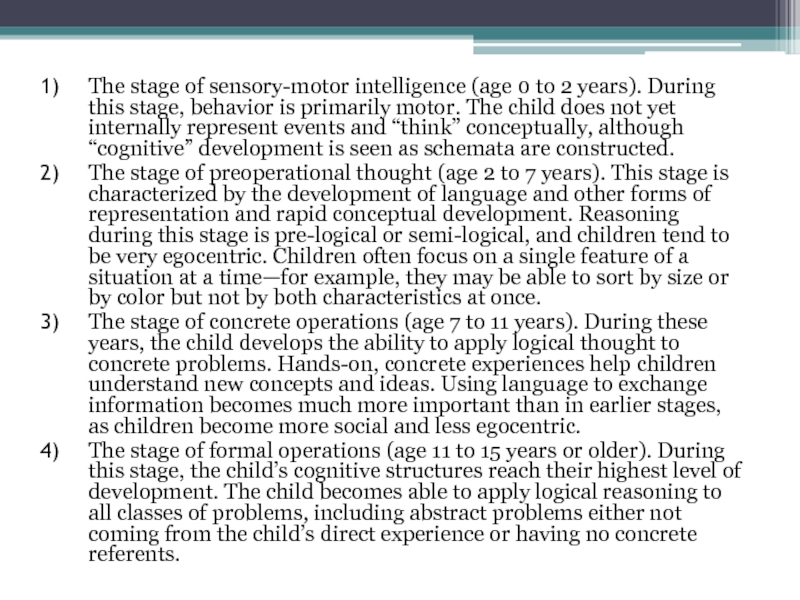
Слайд 14Piaget discusses several processes relevant to the way children know
and understand the world: through schemas, assimilation and accommodation, organization
and equilibration. Schemas refer to what develops in the brain of a child while trying to construct and understand the world - in other words, mental representations organizing the knowledge. Piaget argues that a very young child would be characterized by behavioral schemas (simple physical activities like grasping something or watching someone) whereas later on, mental schemas develop (meaning cognitive activities such as strategies for problem solving or the classification of objects). Adults of course have much more complex schemas of functioning in the world than children do.
Слайд 15Piaget used the terms ‘assimilation’ and ‘accommodation’ to refer to
the process through which children construct their new knowledge. Assimilation
usually takes place when the children’s new experiences are incorporated into or fit in with the image of the world they hold in their minds. On the other hand, accommodation is the process of reconstructing the inner image to fit the new experience.
Слайд 16For instance, if a child has an experience of playing
with a small toy that has a keyboard and screen,
and after some time (no matter how long), the same child comes across a computer, in this case the child will use his/her previous knowledge about that object which is stored in his/her mind to explore the new object which is the computer. The integration of the two experiences broadens the child’s knowledge and facilitates the process of learning. Thus, it can be said that “assimilation and accommodation processes work in a complementary way with each other to give organization to our ever-growing knowledge and understanding”.
Слайд 17Unlike Piaget who argued that “language plays a role in
the development of children’s thinking and understanding but it is
not the driving force”, Bruner viewed language as the most important tool for cognitive growth, and investigated how adults use language to mediate the world for children and help them to solve problems. Supporting a child in carrying out an activity has been labelled ‘scaffolding’ in which the teacher’s task is to push the learner one step at a time beyond where he is now. That is, to provide the child with the necessary support until he/she can stand on his/her own feet. The process of scaffolding focuses on enabling students to develop and move to the next step. “Some teachers, like parents, provide scaffolding intuitively; learning from experience what each learner is capable of and how to give the last little push each needs”.
Слайд 18Bruner added that learning can be achieved by ‘routines’. Cameron
(2001) referred to the research conducted by Bruner with middle-class
American families where parents read bedtime stories to their children. Scaffolding occurs here since the stories are read at the same time each day and because of the fact that the language used by parents includes a lot of repetition. “The repeated language allows the child to predict what is coming and thus to join in, verbally or non-verbally”. Students in the classroom will be familiar, from routines, with activities and instructions which allow them to predict the meaning and intention of new language. Although routines take time to establish, they “make the children feel secure and save a lot of time and explanation in the long run”
Слайд 19However, Piaget’s theory had been criticized because it ignores social
and cultural factors in intellectual development, and therefore many have
turned back to the social constructivist theory developed by Vygotsky. Unlike Piaget, Vygotsky gave a much greater priority to social interaction. For him, “social factors play a vital role in intellectual growth. He assumed that all individual construction was mediated by social factors. For example, the teacher had to model or clarify information to be taught. “The child, then, constructs his or her own internal knowledge from what is modelled. The child does not invent, but very much ‘copies’ what is socially available. This is seen a process of transmission from culture (teacher) to the child”. This sort of interaction is considered by Piaget as “intervention by the teacher and could lead to superficial rote learning and not genuine understanding and progress”.
Слайд 20Vygotsky emphasized the role of the child’s interaction with the
people around them, such as parents and peers, and therefore
he stated that “with the help of adults, children can do and understand much more than they can on their own”. What the child can do with help of the adult is known as the child’s ‘zone of proximal development’ (ZPD) which was defined by Vygotsky (1978) as;
“ the distance between the actual development level as determined by independent problem solving and the level of potential development as determined through problem solving under adult guidance or in collaboration with more capable peers”
Слайд 21Principles of Teaching Young Learners
1 - Create a pleasant relaxed
atmosphere in the classroom
The more relaxed and pleasant the
atmosphere is, the more motivated the learners become. This is related to the problem of anxiety, which had been well discussed by Hymes (1971). He argued that a tense classroom creates anxious students, and thus their motivation will be very low, which will affect their learning process. Some Libyan young learners used not to be as active as they should all course long to avoid the teacher’s negative comments, where he did not believe in learner’s mistakes, and used to consider these mistakes as sins. This attitude made them feel tense and not motivated at all in his class. Therefore, it is mainly up to the teacher to create a positive atmosphere.
Слайд 222- Present the task properly
Application of better teaching methods
increases the motivational levels of the learners. In other words,
presenting the tasks in an interesting manner creates a positive attitude towards learning. Teachers should try to change the way they present tasks by attracting the learner’s attention through the use of games, videotapes and flash cards according to the level of their language and age as well as by using cognitive based activities, in order to break the everyday routine that the learners expect from their teacher, and to raise the level of attention of students.
Слайд 233- Develop a good relationship with the learners
Al-Moghani (
2003) pointed out that the value of developing good relationships
between teachers and students is well known among teachers in general, and among teachers of a second language in particular. However, “personal relationship between students and teachers is not common in Libyan schools. It is believed that certain distance should remain between students and teachers in order to maintain the relation of respect expressed towards teachers.
Слайд 244-Children are full of energy therefore, according to Asher, a
professor of psychology, suggested that primary teachers may find it
helpful to associate language learning with physical responses which is more effective with children compared with adults as they are very active and as a result will appreciate the enthusiasm gained from TPR classes.
Слайд 255- Activities should be fun and enjoyable, Moon (2000) emphasizes
the idea that activities should be fun for children to
keep them motivated and interested. In addition, according to Piaget’s theory, learning occurs when children take action, so children can learn English better by doing.
Слайд 266- Support and guide your students
Children need to be supported
and guided, making them interested in the activity, and showing
them how to do it while controlling their frustration during the process of learning .
7- Recycling For better language learning, language items should be recycled wherever possible using different activities in which each is based on the information presented in the previous activity. e.g: listening to something then talking about it and after that reading the same thing.
Слайд 278- Create and encourage cooperative work One of the main
principles of teaching young learners is that they should have
the opportunity to interact and socialize with others around them, as recommended by Vygotsky who postulated that “all cognitive development, including language development, arises as a result of social interactions between individuals” . Thus, for the benefit of the learners, teachers should think about creating a situation in which the maximum interaction can be established. In the case of Libyan learners where the English language is not used outside the classroom, ‘language games’ which were described by Roth as a mini social world could be the most appropriate technique through which learners can socialize and interact.
Слайд 28
Conclusion
Researchers interested in teaching young learners have proposed various ideas
and principles that can guide language teachers in how to
teach young learners, what skills they should introduce first, how to choose and establish effective activities, and what kind of support young learners need at each stage. Teachers of young learners should have clear idea about the process of acquiring the first language as well as the psychological development of the child. In addition, they should know how and when learners need to be supported in the classroom. For instance, teachers should explain to the children the task, encourage them to carry out it by themselves, encourage learners to ask and answer questions, encourage pair and group work, praise success, and intervene if the group is clearly stuck.
Слайд 29However, principles of learning could vary according to the theory
or method of teaching being used. For instance, audio-lingual methods
view language learning as a habit formation, whereas the communicative approach views language learning as an interactive and cognitive process. Therefore teachers of young learners should be aware of the different theories and methods of teaching as well as the principles of learning. They also need to match their educational practices to the ways children think and learn, by understanding the whole child and the nature of the language learning process
Слайд 30References
Brewster, J & Ellis, G. 2001.The primary English teachers guide.
Penguin English guides.
Brumfit, C., & at el., 1991. Teaching English
to children: from practice to principle London: Collins ELT.
Cameron, L., 2001. Teaching languages to young learners. Cambridge University Press.
Beilin, Harry, Piaget’s enduring contribution to developmental psychology, Developmental Psychology, 1992, no. 28, pp. 191–204
Papert, Seymour, http://www.papert.org/ Accessed January 2018
Harmer, J., 2001. The practice of English language teaching. Longman
Hymes. D., 1971. On Communicative Competence. Philadelphia, PA: University of Pennsylvania press.
May, T., 2005. Top ten teachers celebrate in style. Metro Newspaper, 17 .10.2005. P:7).
Klein, K., 1993. Teaching young learners. Forum , 31 (2), 14
Lightbown, P. & Spada, N., 1999. How languages are learned. Oxford University Press.
Rixon, S., 1999. Young learners of English: some research perspectives. London: Longman.
Scott, W. and Ytreberg, 2001. Teaching English to children. Longman
Al-Moghani, M., 2003. Students’ Perceptions of Motivation in English Language Learning in Libya Thesis (PhD). Durham University.
Bruner, J., 1983. Child’s talk: learning to use language. Oxford: Oxford University Press.
